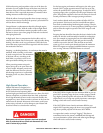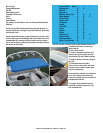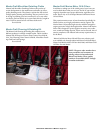
lifting the boat
When the boat is hoisted from the water,
proper use of the stern eyes or a sling
system is required for all MasterCra
models. ough stern eyes are designed
to li a boat from the water, care must be
taken to ensure you do not damage your
boat. A spreader bar used at the stern,
will help ensure that the load at the stern
eyes is vertical. A strap placed between
stern eyes, and then lied from the mid-
point, is not the recommended method,
and will put substantial additional stress
on the stern eye mounting location.
DO NOT use the ski pylon or any por-
tion of any tower for lifting. They are NOT designed to be used
as a central lifting point. Also, DO NOT use the stern ski tow as
a lifting ring. The deck may be damaged. See the Storage Cradle
sub-section of this section. Also never lift a boat with water in the
bilge or containing a water-lled device such as a ballast system
or sack. The extra stress will put an excessive load on the hull
and lifting equipment that may seriously damage the boat. Such
damage may not be covered by the warranty.
Using Lifting Eyes
An overhead hoist with a minimum two-ton capacity should be
used to li your boat. Cables should be properly rated for each
model. Each cable should be rated at or above the full weight of
the model to be lied. When liing, keep the bow slightly higher
than the stern to prevent any possibility of water running into the
engine exhaust manifold.
Using Lifting Slings
An overhead hoist with a minimum two-ton capacity should be
used. Slings must be six (6) inches wide by twenty (20) feet long
and each sling should have a minimum capacity rating that is
equivalent to the weight of the model that is to be lied. Use an
eight-foot spreader bar on each sling to prevent damaging side
pressure to the deck or gunwale molding.
Lifting slings must never contact shafts, struts or hardware
protruding from the hull. Damage may result that would void the
warranty.
When the boat is out of the water, it is important to support the
hull correctly to avoid any hull damage. Such damage may void
the warranty.
Storage Cradle
If a storage cradle is used, the hull must be properly supported
to prevent load damage. is can occur with as little as een
(15) pounds per square inch of pressure. DO NOT support the
boat by resting the hull on the keel (the central fore-and-a
structural member in the bottom of the boat’s hull, extending
from the bow to the stern). Vertical supports must extend from
the chine (the angular intersection of the bottom and sides of
the boat) to the keel with no gaps between the hull and cradle
supports. A total support area of at least 250 square inches is
required for proper support of boats under 25’ and 500 square
inches for boats over 25’. Protect all items extending from the
hull (i.e., the rudder, propeller, ns, etc.) to prevent them from
resting on the cradle or the ground. DO NOT apply any load
stress to the propeller, sha, rudder, swim platform, water intake
grate or other protruding items.
MasterCraft 2009 Owner’s Manual - Page 11-1


















